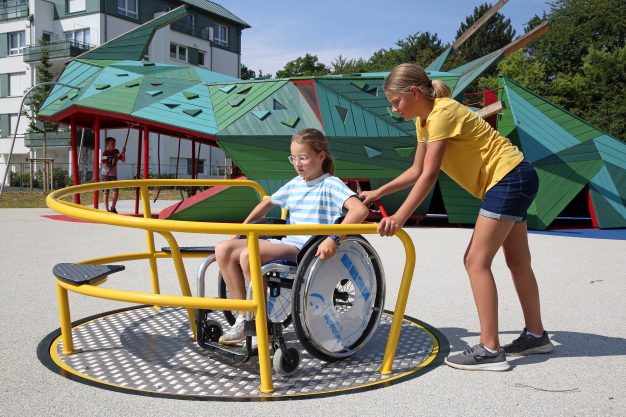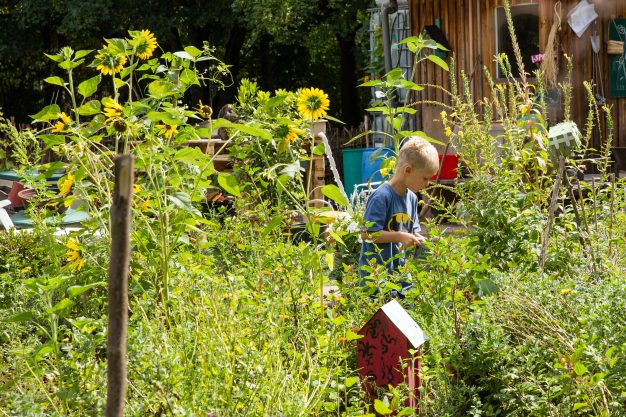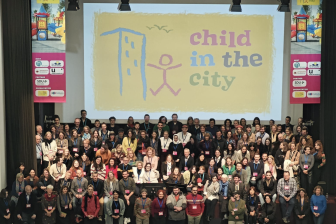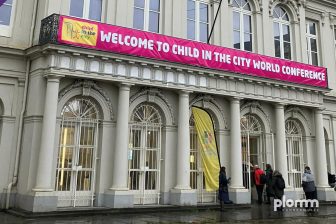
Child in the City International Seminar 2022 – Meet Anna Schledorn, City of Regensburg
The German city of Regensburg has for years been a shining example of how municipalities can develop sustainable child-focused quality standards that can withstand crises – even a pandemic. One key individual who has been at the heart of developing its robust policies is youth and welfare planner, Anna Schledorn. Due to present at our forthcoming International Seminar in Cascais, she spoke to Child in the City.
Child in the City: Can you please give an outline of your role, and also that of the department and/or organisation you work for?
Anna Schledorn: I am the youth welfare planner of the department of municipal youth work of the city of Regensburg. I have been working in this position since February 2007. Besides planning our youth services, I am in charge of the family friendliness and child friendliness of the city, as well as youth participation. I have been managing our child-friendly city program from the very beginning in 2012. In fact, our city was the first city in Bavaria and one of the first ones in the country when it was launched in Germany.

CiTC: The seminar in Cascais is focused on how to ensure children’s rights become mainstream in local policy planning. How does society begin to approach the issue?
AS: More and more communities realise that children’s rights have to be acknowledged in local policy planning, but many seem not know how to approach the issue. In many cities it is approached with projects and unfortunately is very dependent on the goodwill of the people in charge. That means that when somebody is in charge, who is pro- child rights, then good projects can be done. However, as soon as the person in charge changes, often the projects are cancelled. I believe that projects can be a good approach to try something new. But in general children’s rights are a right and the implementation mustn’t depend on the goodwill of politicians and the city administration. The implementation of children’s rights must be given under any government.
‘Regensburg has years of experience in family-friendly politics’
This is different in my city than in many other communities. I believe the main reason is that Regensburg has many years of experience in family and child-friendly politics, and over the decades has learned from these experiences and set up reliable structures that guarantee the implementation of children’s rights.
Regensburg’s politicians realised in the 90s that family friendliness – good living and working conditions for parents, children and teens – is an important factor for the wellbeing and future of our city. So already 30 years ago the city was starting to invest time and money to start its journey towards more family and child friendliness.
Over the years, the city, the politicians, as well as the city administration learned what works well, what to take into consideration and how to approach the topic.
By now, the child and family friendliness is not based on projects anymore but the city has successfully developed standards, regulations and processes that have made children’s rights mainstream in politics and all planning of the city administration.
CiTC: What particular, or unique challenges, did Regensburg face as it began its journey to develop the standards, regulations and processes that have delivered the positive results?
AS: The main challenge was the transition from projects to sustainable structures that stay effective even under changing local governments and ensure a reliable implementation of children rights, also in areas that traditionally have not been faced so much with the challenge of taking children’s right in account. For example, youth and family services, or the department of education, traditionally deal with the welfare and needs of children. However, departments handling urban planning, urban development, economic planning and traffic, for example, would not traditionally focus on children’s rights and children’s needs. Nor have these aspects, for many years, been a topic in the education of the professionals working in such fields of expertise.
In Regensburg, politicians and experts with the city administration have successfully collaborated over the years and together found reasonable solutions and procedures that make children’s rights mainstream.
Another challenge in Regensburg is, that for many years now, the city has been growing rapidly, while empty land is rare. This put extremely high pressure on the remaining land. In Regensburg there is an enormous need for more housing, which clashes with the needs for urban, green, free public spaces and spaces for play. Hence the city had to develop standards and regulations for child-friendly urban planning in order to ensure that children’s need for play and public space are taken into account, even if it might, at first glance, reduce the profits of private developers. However, the long-time experience has proven that the city’s approach is well chosen and sustainable because child-friendly neighbourhoods are more attractive in the long run and provide higher living standards.
‘Child-friendly neighbourhoods are more attractive in the long run’
Regensburg is one of the oldest cities in Germany, and so a very unique challenge for the city comes from its ancient history and UNESCO world heritage status. In the year 179 the Roman emperor Mark Aurel had his soldiers build a fort that became Regensburg. Part of this Roman fort can still be seen today within the old town. Later in the middle ages, especially in the 11th and 12th centuries, the city became the richest and most important trade city in southern Germany and one of the biggest cities in the whole of Germany.

It was basically a free capital and vibrant international metropolis with about 20 000 inhabitants. The citizens built a very dense city, with six-storey stone houses and even higher towers. Most of these houses and monuments are still standing and under historic preservation order. The city was awarded the UNESCO world heritage status for the greatest ensemble of historic monuments.
So our unique challenge, in regard to children’s rights and child friendliness, has been to incorporate child friendliness within this historic setting. The city couldn’t just remove historic buildings to build modern playgrounds, while whatever play structures were installed within the city, the design couldn’t clash with the protected and preserved environment. So the city found ways to embed modern, exquisite designs within historic urban settings that create attractive public space with highest qualities for stay for all generations. Children and youths, naturally, were involved in that process.
CiTC: For too long, city planners across the world have not taken the views of children and young people seriously and instead treated them as an afterthought. What do you think has changed? What more can still be done?
AS: This is a complex issue and I think, to answer this question, two aspects have to be taken into account.
Firstly: Of course developers try to make profit. The more space they can use to build more houses the bigger the profit. Urban green, attractive public space and play grounds are on first sight not profitable. In contrary they cost money. In many places around the world, capitals tend to grow. That means that people move there, more and more urban housing is build and people have less public space and green around them. Now cities can grow in two ways:
Either (A), they can use every little bit of space for new housing and maximum profit without building the above mentioned open space and without taking into account the needs and views of children and youth. This kind of urban development has happened in many cities around the world. In many countries it has led to urban sprawl, unsustainable noisy traffic with long commuting and lots of cars, ghettos, food deserts, and living conditions that are reliable on cars, noisy, unhealthy and segregated. In such cities there are often many social and health problems. This kind of city development is bad for the environment and for the people living there, especially for children. Often in the long run such cities also might see economic problems, because attractive, well-off companies and experts will leave such places and seek out more attractive environments.
Or (B), the city can develop in sustainable ways with public spaces that support social interactions within the community, play and healthy physical exercise, short routes to points of interests like stores, doctors, work, schools and child care facilities, sustainable traffic that is not only climate friendly but also safe enough to ensure an independent mobility for children and youth, attractive neighbourhoods with healthy living conditions.
‘The costs of inhumane and unsustainable urban development are just too great to maintain’
Fortunately there are more and more communities that have realised that in the long run, cities can only develop in a sustainable way, when they develop in a way that ensures healthy and high quality living conditions and strengthens the communities. And such a development is good for people all ages, but especially good for children and youth. It might at first sight seem more expensive to build such sustainable child friendly cities, but in the long run money will also come in and the cities will thrive because attractive companies and experts will seek out attractive cities.
I believe that in many cities politicians and urban planners have realised that in order for a city to thrive in the long run, it has to be attractive and sustainable, even if it might initially, appear to cost more. The costs of inhumane and unsustainable urban development are just too great to maintain long-term. That’s how urban planners started to take the needs of all generations more into account. However, many cities like Regensburg find themselves in a competition for highly trained professionals and experts. Those experts often are young or middle-age adults who have children or at some point want to start a family. In order to attract such experts, the city has to be attractive for families, which in turn means it has to provide good living conditions for children. That’s one reason why children and youths became increasingly the centre of attention for urban planners. But then some urban planners realised that they did not really know what children needed and how to plan in a child-friendly way and so, in cooperation with experts working with youth, who had been trying to implement children’s rights, they realised the best way to do child-friendly planning is to ask children and youth themselves, to let them participate and to take their view into account.

Regensburg’s politicians and city administration seems to have been a little ahead of its time in the 90s when they deliberately decided to support child friendly city development.
Second, The United Nations Convention on the Rights of the Child is now 30 years old. So for 30 years professionals who work with and for children have tried to implement the convention and to strengthen children’s rights. One of these rights is the right to participate and take the view of youths into account.
After centuries of city development without child participation of course it took a while to change the approach of urban planning. I believe that the work of child advocates, social workers and whoever has been working on promoting children’s rights is finally more and more showing some effects – even in the field of urban planning. Some cities however have still not understood that they must acknowledge the needs and views of young people. However, there are more and more communities that have successfully shown how beneficial this approach is, which in turn helps to convince more and more communities to follow this example – especially when combined with the above mentioned pressure to provide child-friendly living conditions in order to be attractive for a high-performing population.
CiTC: COVID has affected the world like nothing else before. What challenges has it presented to Regensburg’s education and child care policymakers, and how has the city responded?
AS: One of the biggest challenges for our city was that the laws and regulations were passed on state and country level and the city had by law a very restricted scope of possible actions. Unfortunately many of the restrictions hit children and youth very hard. However the city did try very hard to support children within these state regulations. Some examples are:
- Emergency child care for parents who were essential workers, single parents, children with special needs and children that the family and youth services determined that for their wellbeing they needed child care
- A newsletter with important information and advice about family live during Covid: Stadt Regensburg – Familien – Familienleben in Zeiten von Corona
- Social workers continued to work with families in need
- Staff at the closed youth centres in all neighbourhoods stayed in contact with the children and helped them with practical issues, like printing out homeschooling assignments.
From the moment in May 2020 that playgrounds were allowed to reopen, our child-friendly city planning and city development proved to be very sustainable and crisis-proof. Meanwhile other cities and communities reported that they still had to close playgrounds because they had so few and too many people would use them at once.
Being able to use attractive playgrounds and to play freely outdoors improved the well-being of children and youngsters tremendously. It also proved very sustainable that all the youth centres in Regensburg have attractive open outdoor space for kids.
CiTC: What elements of the work in your city could be shared and adopted by others around Europe, and around the world?
AS: There are many elements of our work that could be shared and adopted. That is why our city has often been asked to counsel other cities and provide advice and best practice examples for other communities in various areas of expertise.
We have good practice examples for developing reliable standards and practices for child-friendly urban development, urban planning, mobility, youth work.
In regard to participation we have good examples of a well-functioning youth council, a children’s council, as well as youth pacification in urban planning, in urban design and in planning playgrounds. One element of the work in my city is the method “Spielleitplanung” which we successfully adopted to create ‘masterplans’ of play with youth participation in urban neighbourhoods. I have guided cities in Germany, Austria and China about this work.
Regensburg also has great examples of very child-friendly youth work, a good example being our Spielbus Regensburg play truck that drives every week to a different neighbourhood. And we also have our neighbourhood family centres, which are vitally important places for supporting young parents, preventing troubled childhoods and strengthening parenting skills.
An interesting example on how our city supports independent child mobility are our child emergency islands. For this project the city cooperates with local businesses to provide places to go in case of emergency support, independent mobility of children and teens, and strengthening ‘free range parenting’.
CiTC: You will be presenting details of your work at the Child in the City International Seminar in Cascais. If you could have the audience take away just one key message on the day, what would it be?
AS: Child friendliness cannot solely be a youth work project. Child friendliness has to become an attitude of all the politicians and the entire city administration. There have to be reliable standards and procedures that always apply and make child friendliness and children’s rights an interdisciplinary topic that is considered in all the decisions that have to be made. My message is is that this is possible. The City of Regensburg has reached this goal, is doing it successfully and other cities can do so as well.
All photos and videos: copyright City of Regensburg
The seminar takes place from May 19-20 in Cascais, Portugal. Have you registered to attend? Click here for more information




